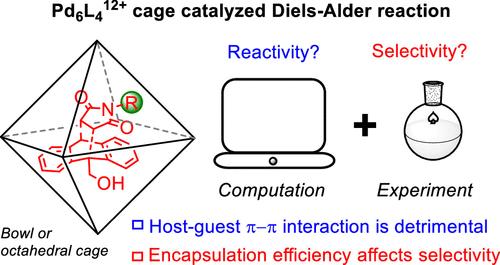重新审视pd6l4 -笼催化Diels-Alder反应的反应活性和选择性:计算和实验相结合的研究
IF 4.7
2区 化学
Q1 CHEMISTRY, INORGANIC & NUCLEAR
引用次数: 0
摘要
超分子金属有机笼(moc)由于其自组装结构和良好定义的腔体,模拟酶活性位点并实现空间限制,作为多功能催化平台而受到关注。这种限制调节了反应途径,提高了催化性能。最近的研究强调了它们在各种有机转化中的催化潜力,但控制moc催化反应的因素仍然不完全清楚。这项工作建立在先前钯基MOCs催化Diels-Alder反应的计算研究的基础上,表明通过π -π相互作用实现过渡态稳定的普遍观点是不成立的。相反,我们发现底物和配体之间的π -π相互作用使过渡态不稳定。此外,区域选择性的理论研究,实验验证,表明底物封装效率是决定反应选择性的关键。这些发现为moc催化反应的机理提供了新的见解。本文章由计算机程序翻译,如有差异,请以英文原文为准。

Revisiting the Origins of Reactivity and Selectivity in the Pd6L4-Cage-Catalyzed Diels–Alder Reactions: A Combined Computational and Experimental Study
Supramolecular metal–organic cages (MOCs) have gained attention as versatile catalytic platforms due to their self-assembled architectures and well-defined cavities, which mimic enzyme active sites and enable spatial confinement. This confinement modulates the reaction pathways and enhances the catalytic performance. Recent studies highlight their catalytic potential in various organic transformations, but the factors governing the MOC-catalyzed reactions remain incompletely understood. This work builds on prior computational studies of Diels–Alder reactions catalyzed by palladium-based MOCs, showing that the common view of transition-state stabilization via π–π interactions is not valid. Instead, we find that π–π interactions between the substrate and the ligands destabilize the transition state. Additionally, theoretical studies of regioselectivity, validated experimentally, suggest that substrate encapsulation efficiency is key to determining reaction selectivity. These findings provide new insights into the mechanisms of MOC-catalyzed reactions.
求助全文
通过发布文献求助,成功后即可免费获取论文全文。
去求助
来源期刊

Inorganic Chemistry
化学-无机化学与核化学
CiteScore
7.60
自引率
13.00%
发文量
1960
审稿时长
1.9 months
期刊介绍:
Inorganic Chemistry publishes fundamental studies in all phases of inorganic chemistry. Coverage includes experimental and theoretical reports on quantitative studies of structure and thermodynamics, kinetics, mechanisms of inorganic reactions, bioinorganic chemistry, and relevant aspects of organometallic chemistry, solid-state phenomena, and chemical bonding theory. Emphasis is placed on the synthesis, structure, thermodynamics, reactivity, spectroscopy, and bonding properties of significant new and known compounds.
 求助内容:
求助内容: 应助结果提醒方式:
应助结果提醒方式:


